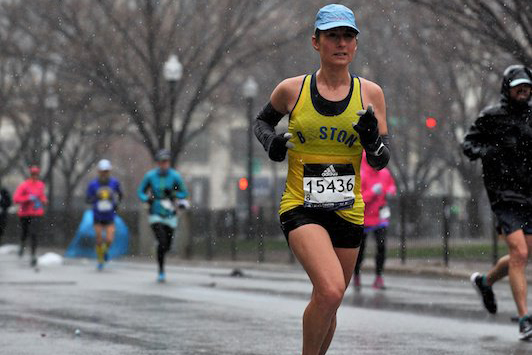
Photo courtesy of @EntirelyAmelia, Twitter
Recently, the magazine Canadian Running published a piece highlighting the achievements of three transgender women who managed to qualify for the women’s division of this year’s Boston Marathon, Stevie Romer of Woodstock, Illinois, Amelia Gapin of Jersey City, New Jersey and Grace Fisher of Hancock, Maryland.
Officials of the prestigious event also commented on the development, citing no explicit policy on trans runners while also stating that they have a “strong emphasis on inclusion” in a report from NPR.
This has been a celebrated achievement for trans-community, though it has been met with criticism regarding a perceived unfairness towards cis women having to compete against people who were assigned as men at birth.
The reasoning of these critics starts with the fact of men and women performance differences in sports. In most physical sports, when men and women athletes at the highest level of competition are compared based on their performance; a deficit hovering around 10 percent appears in which women competitors lag behind men competitors; though this varies depending on the physical sport.
In terms of marathon running, the top women performance takes up 91.3 percent of the top men performance, leaving a 9.7 percent gap according to the Journal of Sports Science Medicine. With this in mind, critics then argue that since transgender women are, in terms of biological sex, males that it would be unfair for them to compete as their identified gender in competition.
The assumption made in this argument is that sex chromosomes along the conceptualized XX/XY binary are the main factor in determining performance. However as any biologist worth his salt would know, the genes don’t have the direct phenotypic effect, but rather the gene products and their subsequent expression.
In this case, testosterone and its high level of expression in human males compared to females is largely responsible for the development and maintenance of males greater muscular mass, bone density, etc. If this genetic testosterone expression is suppressed, and more female hormones such as estrogen are introduced, then the body would diminish in said features.
Funnily enough, what I just described is Hormone Replacement Therapy (HRT). For trans-women who undergo the procedure, this involves taking the testosterone blocker, spironolactone, and the synthetic estrogen, estradiol. As a result, trans-women often face decreases in muscle mass and bone density.
This is not to suggest that all trans-women should undergo HRT, as that is a very personal decision. However, for the ones that do, gender segregated sport leagues and events should be open to them to participate as their identified gender.
This is the opinion shared not only by me, but by the International Olympic Committee who require a full year of testing testosterone levels below 10 ng/dL for trans-women seeking to compete in women divisions. Critics might say that despite this trans-women might still be outliers expressing testosterone levels above the average upper phenotypical limit for females. But that's the rub isn’t it, average.
There are always outliers in every sport; cis women could express testosterone levels higher than the average range, or below the average range. This doesn’t bar them from competition, and neither should it for trans-women. The fact is that so long as sport remains a reasonably fair event for all competitors, inclusion should be prioritized.
dirons@ramapo.edu





